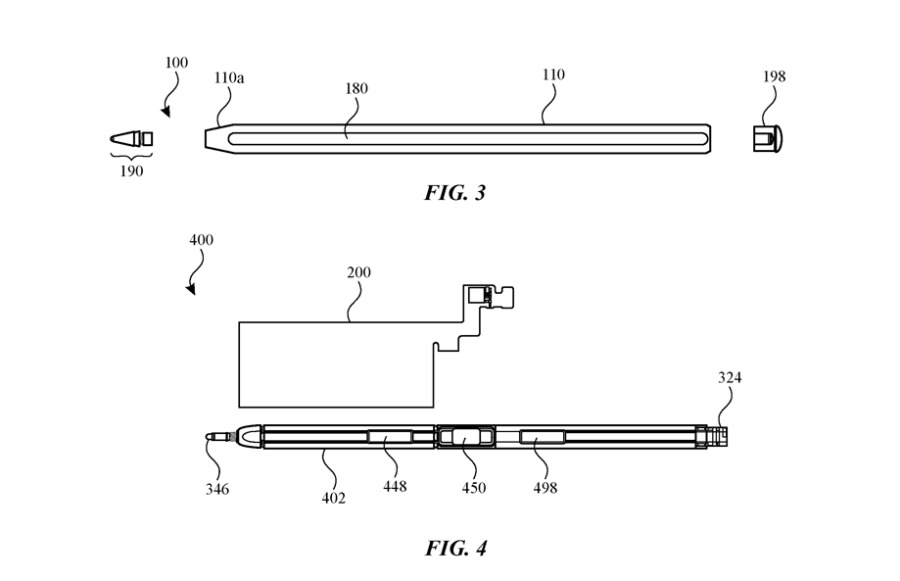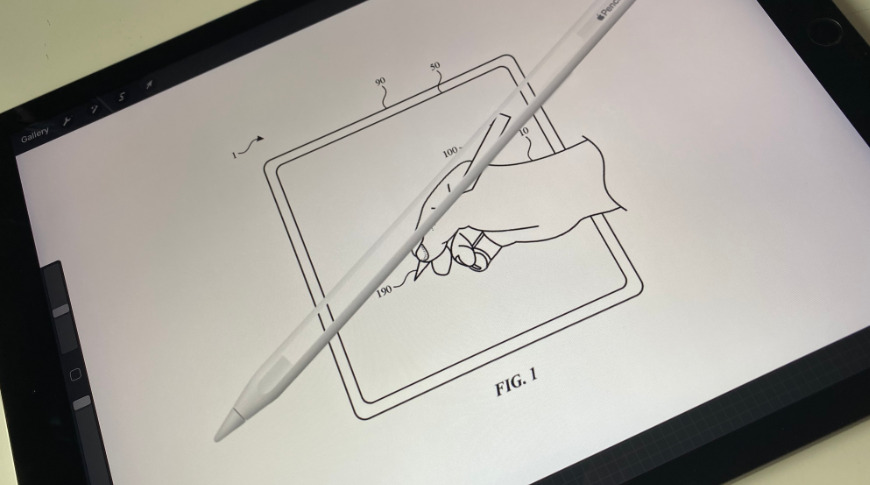Glass incorporated into a future Apple Pencil may add Touch Bar-like controls to the device, and also display a view of the drawing that it would normally block from the user.
Apple continues to explore new additions to the Apple Pencil, with two new patents coming on top of recent ones about touch controls, better simulating paper, and even changing shape for comfort. The new ones involve haptic feedback and guidance, and displaying more information on the Apple Pencil itself.
The details of what that information could be are described in "Stylus with a Glass Component." It says that the tip or the current flat side of the Apple Pencil could be made of glass, and that this would facilitate both input and output. A Pencil could have more touch-sensitive areas, and it the glass part could be used as a limited display.
This patent application describes the use of glass as being an overall improvement to an Apple Pencil, too.
"[Plastics] and coating layers are generally porous and susceptible to infiltration by debris," notes the patent, "especially when the stylus is frequently handled and contacting other surfaces."
"[Consequently, glass instead] provides a durable outer surface along a section of the stylus to resist infiltration of debris and reduce the effects of wear," it continues. "The glass member can be provided in a variety of shapes and arrangements that offer aesthetic options and customization for personal preferences [and] can also facilitate detection of touch input with a capacitive touch sensor within the stylus."
With the touch sensor, the Apple Pencil would gain further controls.
"[It] can be used to detect a tap, double tap, triple tap, or another tap gesture by the user," continues the patent. "Additionally... the touch sensor can be used to detect a sliding gesture by the user [or] a rolling gesture by the user."
So the Apple Pencil may be able to detect when a user slides a finger across the glass, or just rolls the Pencil in his or her hand. The former could be used to, for instance, let the user alter the thickness of a pen stroke, while the latter might be a way of expanding on the sensitivity of selection.
 Detail from the patent showing options for where a display and greater touch-sensitive controls could be
Detail from the patent showing options for where a display and greater touch-sensitive controls could beIn a similar way to a previous patent proposing a color LCD tip for the Apple Pencil, this new application describes showing colors across the glass side of the stylus body.
The Apple Pencil itself could show, for example, the currently-selected color from a pallete.
More dramatically, the glass side of the Pencil could show something of what the user would see if the Pencil were not there at all.
"[A] stylus can replicate the display of a representation that is also displayed on the host device," says the patent. "For example... the stylus, through the glass member, can replicate at least a portion of the representation."
So the Pencil can be aware of what, for instance, an iPad screen — or "host device" — is showing, and show the portion of that which its stylus body would otherwise block.
"The stylus and/or the host device can estimate what portion of the glass member is between the user and the displayed representation," continues the patent. "Such an estimate can be based on the position and/or orientation of the stylus and/or the host device... The resulting representation displayed through the glass member can give the appearance of the underlying representation so the user is able to see the portion of the representation that is otherwise blocked from user by the stylus.
This would effectively make the Apple Pencil semi-transparent.
A second new patent application regarding the Apple Pencil would give it something else invisible, the ability to pull or tug the user's hand as a way of guiding the user.
Another application, "Input Device with Haptic Feedback," initially seems to be just one of the very many haptic patents Apple has filed for it.
However, this one is concerned with the use of magnetic coils within the Apple Pencil to do more than respond to taps or presses of the tip against a screen.
"[The] haptic feedback can be a push force pushing the input device away from the device or a pull force pulling the input device toward the device," says the patent. "In some examples, the haptic feedback can guide the input device (e.g., with a lateral force). The haptic feedback described herein can be used for writing, drawing or actuating virtual input controls (e.g., buttons, sliders, keys, etc.) in the user interface."
So as a user is holding the Apple Pencil near an iPad's screen, this haptic feedback could tug them toward where the device's app believes they want to go.
"For example, guidance can be provided to assist a user draw straight lines or other shapes (e.g., circles, ellipses, rectangles, etc.) or pictures or logos, etc. that are displayed (or not displayed) on the touch screen," continues the patent.
This guidance would not be limited to drawing, either. When the iPad is showing a virtual keyboard, such an Apple Pencil could help with typing.
"[The Apple Pencil] can be pulled toward more commonly used letters in a sequence of letters (e.g., those with high probability of being the intended input) or pushed away from less likely letters (e.g., those with a lower probability of being the intended input)," explains the patent.
For example, if a user selects the letter "Q" to begin a new word, the Apple Pencil can pull them toward "U," the most likely next letter.
 Detail from the patent showing how after tapping the letter "Q," a user could be guided by the Apple Pencil to the most likely next letters
Detail from the patent showing how after tapping the letter "Q," a user could be guided by the Apple Pencil to the most likely next lettersAlongside invisibly guiding a user when they're actually using the Apple Pencil, this patent's magnetic coil system would have one further benefit. When a user is not holding the Pencil, and instead is just resting it on the iPad's surface, it should be able to detect this and so automatically prevent the Pencil rolling off.
This haptic patent is credited to the prolific Paul X. Wang. His many previous patent applications include related ones such as the Apple Pencil adjusting its own shape, or new fingertip mapping tools.
The patent application regarding an Apple Pencil with a glass side is credited to Yi-Heng Sen, Alex J. Speltz, and Alex M. Lee. Sen and Speltz were both previously credited as inventors on "Haptic actuator having movable bodies along an arcuate path of travel and related methods." Lee has prior haptic patents, too, but is also credited on one for "Tactile switch assembly in an electronic device."
 William Gallagher
William Gallagher







-m.jpg)






 Marko Zivkovic
Marko Zivkovic
 Christine McKee
Christine McKee
 Andrew Orr
Andrew Orr
 Andrew O'Hara
Andrew O'Hara


 Mike Wuerthele
Mike Wuerthele
 Bon Adamson
Bon Adamson



-m.jpg)



6 Comments
Wow, that sounds so cool! I'd definitely love to see some of these features in future Apple Pencils.
Can't imagine the price Apple would sell this Pencil for!
Stop stroking your pencil !!!
Hm, not sure this would work for the whole surface of the pencil, since the greater distance offset from the screen couldn’t be calculated (unless you wore a tracking device on your head). The tip though, that might be doable, since it’s quite close to the screen, reducing the offset factor. Remember, this kind of “pass through” invisibility only works from one angle.